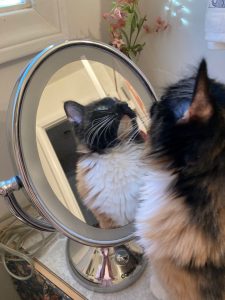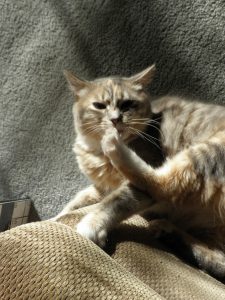Note: Monday’s post is late because of a website glitch. I’ll follow tomorrow with Wednesday’s post and bring you Friday’s post on Saturday.
 Cats are certainly good at grooming. Most of them are fastidious when it comes to personal hygiene. Some cats will help us with our grooming, as well—licking our hand or face while we’re cuddling with them. And cats groom other cats—their kittens, their housemates–feline or canine, a random cat they meet up with in the yard.
Cats are certainly good at grooming. Most of them are fastidious when it comes to personal hygiene. Some cats will help us with our grooming, as well—licking our hand or face while we’re cuddling with them. And cats groom other cats—their kittens, their housemates–feline or canine, a random cat they meet up with in the yard.
The grooming routine of a cat is traced back to their  wild cat ancestors who relied on fastidiousness for their very safety. A tiger or lion or cheetah cannot risk detection from the scent of the last thing they ate, so after eating they lick all of the smelly evidence from their fur.
wild cat ancestors who relied on fastidiousness for their very safety. A tiger or lion or cheetah cannot risk detection from the scent of the last thing they ate, so after eating they lick all of the smelly evidence from their fur.
If you’ve ever felt a cat’s tongue on your skin, you know it’s made for cleaning—like the bath sponge you use in the shower. I read the other day that the “barbs” on a cat’s tongue is made from the same substance as is in our fingernails.
 So yes, cats do a great job of grooming, but sometimes they need help. Cats get mats where they can’t reach with their tongue to untangle the fur—around their neck, for example. Some types of fur tend to mat more easily than others and grooming becomes a job the cat can’t manage on her own. Lately, I use my cuddle time with Olivia to work small mats out from around her
So yes, cats do a great job of grooming, but sometimes they need help. Cats get mats where they can’t reach with their tongue to untangle the fur—around their neck, for example. Some types of fur tend to mat more easily than others and grooming becomes a job the cat can’t manage on her own. Lately, I use my cuddle time with Olivia to work small mats out from around her  neck. I unravel the tangles with my fingers, then use a wire brush or comb to finish the job. One small beginning of a mat can take a whole cuddle session.
neck. I unravel the tangles with my fingers, then use a wire brush or comb to finish the job. One small beginning of a mat can take a whole cuddle session.
It’s wise to brush/comb your medium to long-hair cat often to prevent mats and catch those that are just starting. Use a fine-tooth grooming comb to help a short-hair cat shed her undercoat. If you have a cat like  Olivia, though, the tummy and under arms are off limits—“no touchy there, Mom.” So it becomes a more difficult situation. However, if she is relaxed enough I can sometimes get in there and make headway. Blunt-nose scissors are recommended for tough mats. I’ve cut many mats from cats that keep those mats a secret until they’re painful.
Olivia, though, the tummy and under arms are off limits—“no touchy there, Mom.” So it becomes a more difficult situation. However, if she is relaxed enough I can sometimes get in there and make headway. Blunt-nose scissors are recommended for tough mats. I’ve cut many mats from cats that keep those mats a secret until they’re painful.
There are also powders and other products you can use on cat fur that will help to prevent and loosen mats. Choose wisely—make sure the product is safe for your cats and use it according to directions.
on cat fur that will help to prevent and loosen mats. Choose wisely—make sure the product is safe for your cats and use it according to directions.
There are also instructions for dematting a cat on the internet—by people who know more about approaching this task than I do. We’d love to hear from those of you who have discovered successful methods of helping your cat with her mats.

Of course, each cat is different in their fur-type and their tolerance level. What works for one might not work for another. I had a lovely calico years ago who was horribly prone to mats. She and I could manage those on most of her body, except for her tummy. Finally I discovered a solution. Each summer I’d take Daisy to the groomer and have them shave her tummy. The fur always grew back in time for winter, you couldn’t even tell she’d been shaved because the fur fringe around her sides covered our secret. She still looked beautiful and felt so much better. I like that solution better than shaving the whole cat, which is the kindest thing to do with cats that have mats beyond what you or the cat can handle.





